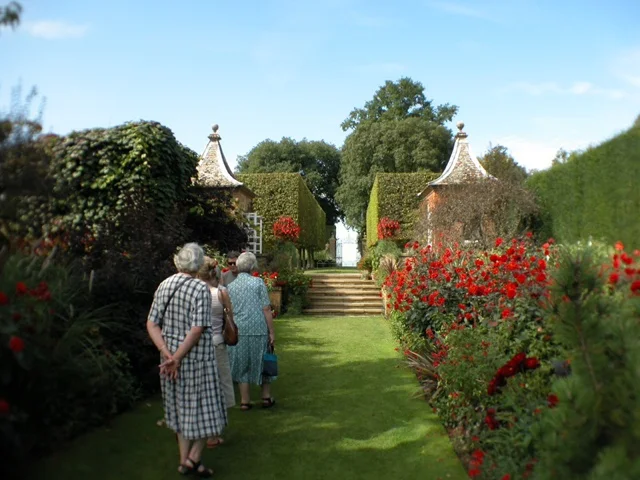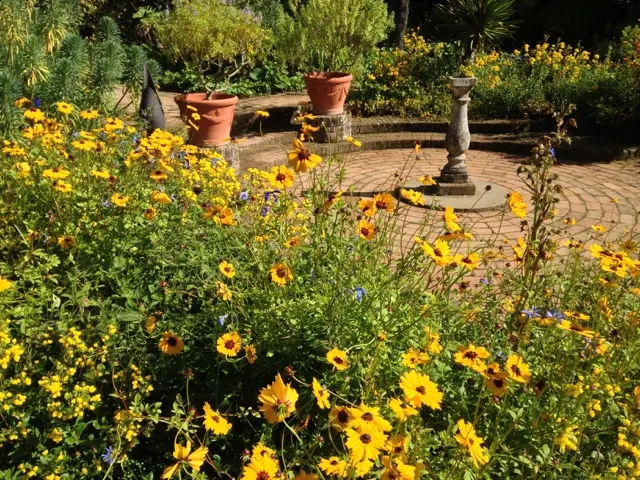There are not many moments quite as thrilling as that when you realize you are the only soul in a garden such as Hidcote on a rainy day… imagining that, however fleetingly, this is yours, and only yours; that this is your domain; your backyard (and not just in it…). Living in close proximity, we have that luxury: that we can indulge ourselves… seeing [the] place anew again and again – and not just for [its] innate, crafted beauty; or [its] extensive historical context; but for the rich, relevant relaxation and deserved, diversionary depth [it] can bring to our restive lives.
I have been visiting “somewhat wind-swept” Hidcote – “the greatest garden I know – with such wonderful rooms and blooms… – which is why I return so frequently” – for nigh on twenty years. And, every time I am there, I do “see the place anew”: such is its genius.
Find a quiet spot and sit on one of the ornate benches and watch green woodpeckers search for their lunch or listen to the calls from the buzzards circling overhead. Time it right and you might catch a glimpse of the elusive hummingbird moth.
– National Trust: Hidcote
Returning, last week, early on a day that initially threatened bursting clouds – the ground was spongy beneath my heavy boots; and the trees hung low: pendulous with the downpours that had preceded me; many weighted, as well, with the season’s rich fruits – new perspectives were forced on me simply through the act of dodging, weaving and bobbing between the burdened branches. As I looked down, trying to avoid the short, chortle-inducing, tickling, localized showers precipitated by my clumsy head flicking the dripping leaves, my concentration was on the paths and the fresh marks I left behind – occasionally straying from the paths to find safer passage on grass and, infrequently, the “damp peaty soil”.
At this time of year, the garden is as dramatically colourful as it can be: the ripening berries; bright crops of diverse apples and pears; summer’s final blossoms (especially the delicate cyclamen, ostentatious dahlias, dark fuchsias, and filigreed lacecap hydrangeas); a hint of fading warmth as the trees prepare for winter (acers at their thrilling, neck-twisting best) – all heightened by the amplified verdancy that only recent rains can bring. (As Vita Sackville-West wrote: Lawrence Johnston, whose creation this paradise was – and is – “realised how many different shades of green there are in Nature… and has made use of all these greens in a way that would have delighted Andrew Marvell.”) And the Red Borders (“a bonfire of colour”) were certainly at their fiery peak; a glowing introduction, under brightening skies, to that most famous view.
By the time I reached my favourite ‘room’, Mrs Winthrop’s Garden (generously named after Johnston’s curmudgeonly mother), the sky was sunny and blue (to match the flowers); and the sundial told its time with a crisp, strong shadow. There were still few other visitors around, though – of the human kind, anyway.
Heading back through the Kitchen Garden to the Rose Walk, I was lucky enough to enjoy the slightly frantic comings and goings of one of those “elusive hummingbird moths” – a display of great grazing aerobatics – Hidcote being one of the few places I have witnessed these amazing creatures. And yet more red admirals: tipsily enjoying the fermenting windfalls.
Overhead, a pair of those buzzards, too – unusually silent – surfed the growing thermals, basking in the stirring sun; most other birds absent both in song and presence – apart from, of course, the archetypal “gardener’s friend”, the robin: bringing yet more welcome flashing splashes of colour (and close by its paler namesake, Robinia ambigua ‘Decaisneana’).
As I departed, the café and car park were beginning to fill. I had timed my visit well; and was rewarded with wonderful Cotswold vistas on my return home.








No comments:
Post a Comment